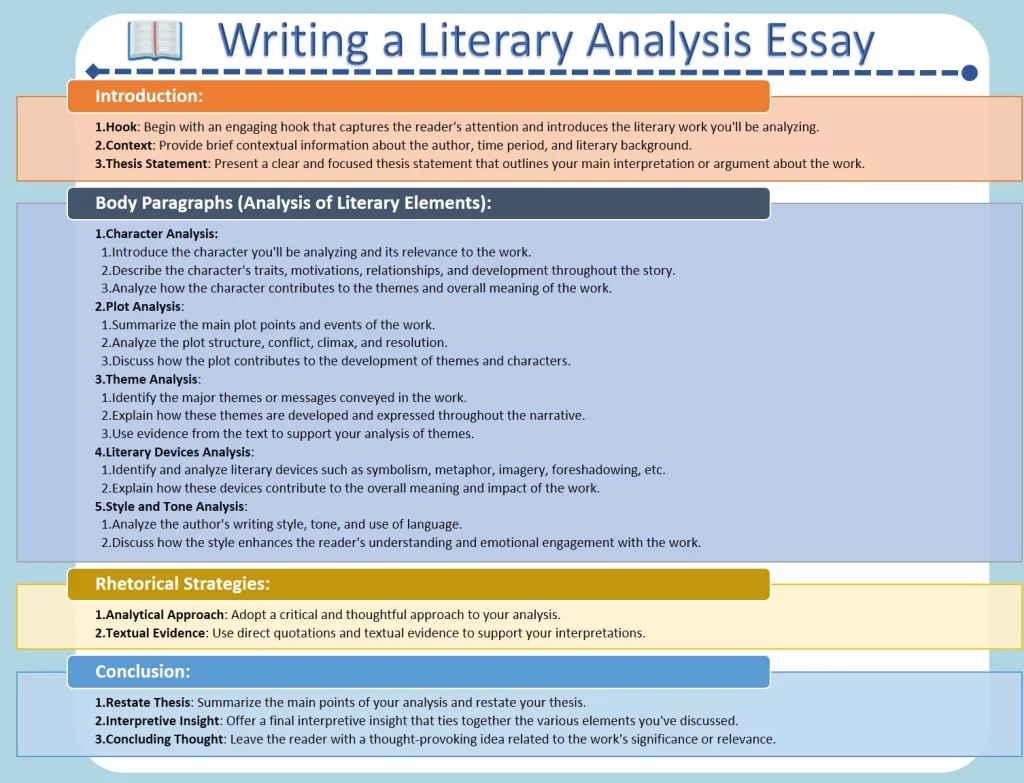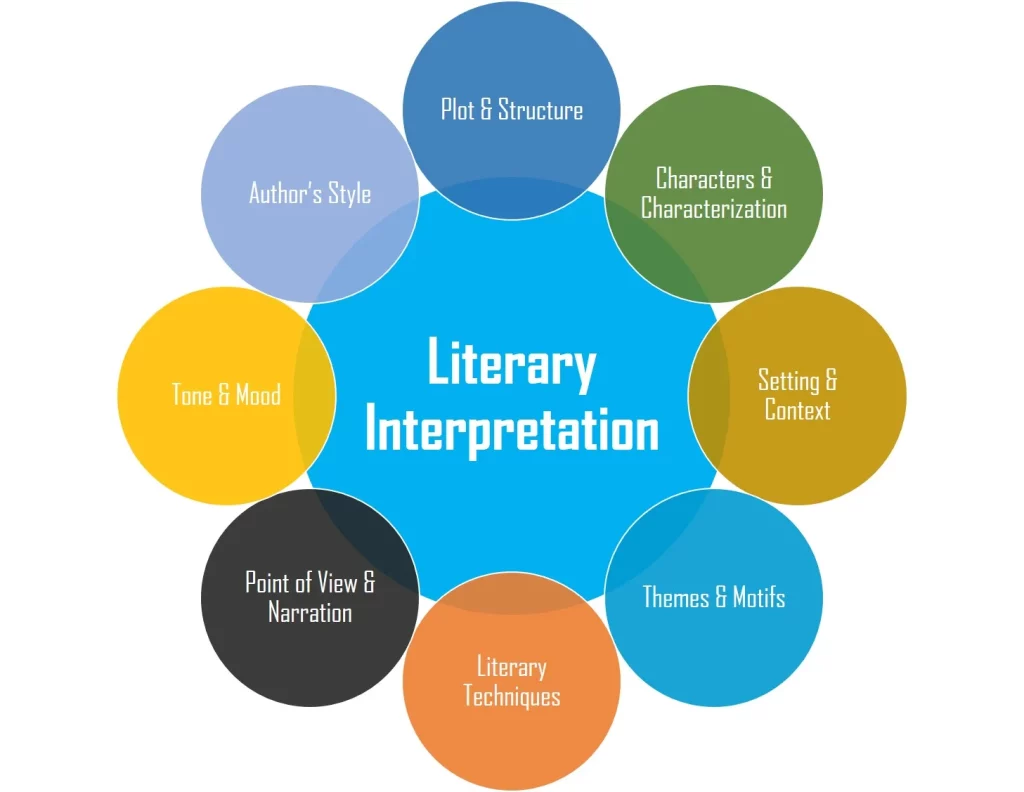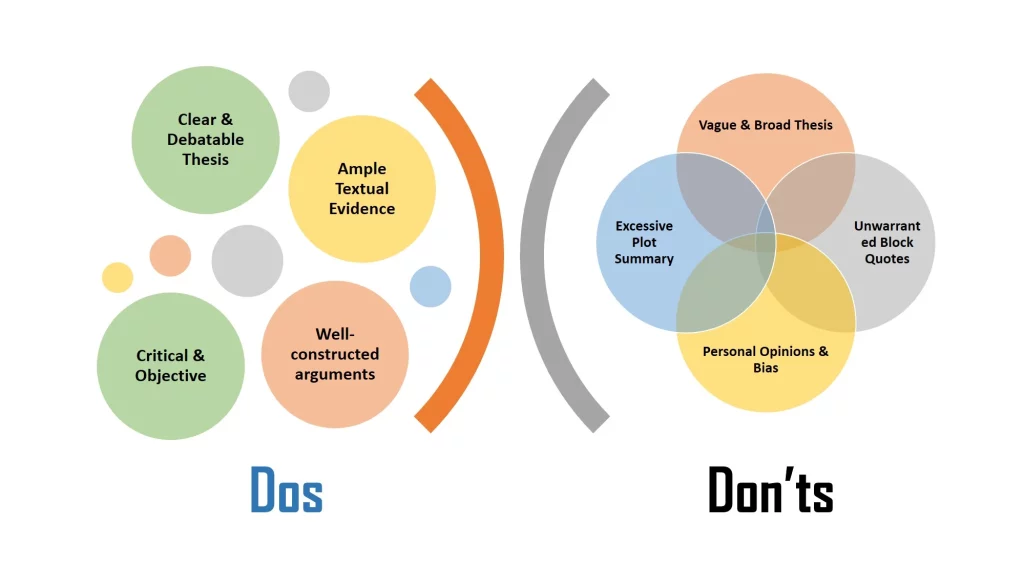
A literary analysis essay is a type of academic paper in which you critically examine and analyze a work of literature, such as a novel, short story, poem, play, or any other piece of literary art. The goal of a literary analysis essay is to explore and interpret the various elements of the text to gain a deeper understanding of its meaning, themes, characters, symbolism, and literary techniques employed by the author. Interpretations are usually argumentative; and are backed by evidence.
- Purpose: The primary purpose of a literary analysis essay is to closely examine and dissect a specific aspect or elements of a literary work. It may focus on analyzing a character, a theme, a literary device, or a specific aspect of the text’s structure in great detail. The analysis is often focused and narrow in scope.
- Approach: This type of essay typically takes a close reading approach, delving deep into the text to extract meaning and provide a detailed analysis. It often seeks to answer specific questions or address particular aspects of the work.
- Scope: A literary analysis essay may focus on a single aspect or element of a literary work, such as the symbolism of an object or the development of a specific character.
- Audience: The audience for a literary analysis essay is typically an academic one, such as a professor or classmates. It aims to demonstrate a deep understanding of the text and its nuances.
- Sources: While a literary analysis essay may incorporate secondary sources for support and context, the primary focus is on close reading and analysis of the text or prompt itself.
Key Distinguishing Characteristics
The key distinguishing characteristics of a literary analysis essay include:
- Focus on a Literary Work or Prompt: A literary analysis essay centers on the examination of a specific work of literature, such as a novel, short story, poem, play, prompt, speech, or literary piece. It is not a summary or book report but a critical analysis of the text.
- Thesis-Driven: It is thesis-driven, meaning it presents a clear and debatable thesis statement that the essay seeks to prove or support through analysis and evidence from the text.
- Critical Analysis: The primary purpose is to critically analyze and interpret the literary work. This involves examining various elements, including plot, characters, themes, symbolism, literary devices, style, and tone, among others.
- Use of Textual Evidence: A literary analysis essay relies heavily on textual evidence, including quotations and references from the literary work itself. These excerpts are used to illustrate and support the arguments and interpretations made in the essay.
- Argumentative: The essay presents arguments and interpretations about the literary work rather than offering a summary or opinion. These arguments should be logical, well-structured, and backed by evidence.
- Depth and Complexity: It delves into the deeper layers of meaning within the text, exploring nuances, subtext, and the author’s intentions. It goes beyond the surface level to uncover hidden themes and messages.
- Engagement with Literary Techniques: It often involves the analysis of literary techniques used by the author, such as metaphors, similes, imagery, foreshadowing, and symbolism, to understand how they contribute to the text’s meaning.
- Multiple Perspectives: A literary analysis essay may explore different perspectives and interpretations of the text. It can consider how various readers might interpret the work in diverse ways.
- Structure and Organization: It follows a structured format with an introduction, body paragraphs, and a conclusion. Each body paragraph typically focuses on a specific aspect of the analysis, and the essay should flow logically from one point to the next.
- No Personal Narration: Unlike a personal essay or reflection, a literary analysis essay avoids personal anecdotes and focuses on the analysis of the literary work itself.
- Citation and Referencing: If the essay includes references to secondary sources, it should follow a recognized citation style (e.g., MLA, APA, Chicago) and provide proper citations for these sources.
- Academic Tone: It is written in a formal and academic tone, avoiding casual language or slang. The focus is on analysis and argumentation.
- Proofreading and Editing: It undergoes careful proofreading and editing to ensure clarity, coherence, and correctness in writing.
In summary, a literary analysis essay is a scholarly examination of a specific work of literature, driven by a clear thesis, supported by textual evidence, and characterized by critical analysis and interpretation of the text’s various elements. It is distinct from other types of essays and focuses on exploring the richness and complexity of literary works. It’s an opportunity for the student to explore the layers of meaning within a piece of literature and to offer your own interpretation and insights.
General Outline
The format of a literary analysis essay typically follows a standard structure, which includes the following elements:
- Title:
- Give your essay a clear and relevant title that reflects the content of your analysis.
- Include a header with your name, instructor’s name, course title, and date (format may vary based on citation style i.e. APA, MLA, etc.).
- Introduction:
- Hook: Start with an engaging opening sentence or two to capture the reader’s attention and introduce the topic.
- Context: Provide some background information about the literary work, including the author’s name, title of the work, and any relevant historical or cultural context.
- Thesis Statement: State your main argument or interpretation in a clear and concise thesis statement. This should be the last sentence of your introduction.
- Body Paragraphs:
- Each body paragraph should focus on a specific aspect of your analysis, and they should be organized logically to support your thesis statement.
- Topic Sentence: Begin each body paragraph with a clear topic sentence that relates to your thesis and sets the direction for the paragraph.
- Evidence: Provide evidence from the text to support your analysis. This may include quotations, paraphrased passages, or references to specific scenes or lines in the literary work. Make sure to cite them properly according to the citation style specified by your instructor or institution (e.g., MLA, APA, Chicago).
- Analysis: After presenting evidence, analyze it by explaining its significance and how it supports your argument. Discuss the author’s choices, literary techniques, and the impact on the reader.
- Transition Sentences: Use transition sentences at the end of each paragraph to smoothly guide the reader to the next point or idea.
- Conclusion:
- Restate Thesis: Begin your conclusion by restating your thesis statement in a slightly different way.
- Summarize Main Points: Provide a brief summary of the main points or arguments you made in the body paragraphs.
- Final Insights: Offer some final insights or observations about the literary work and its broader implications.
- Avoid introducing new information or arguments in the conclusion.
- References or Works Cited:
- If you’ve cited secondary sources, include a separate page listing all the works you’ve referenced.
- Format this page according to the citation style you’re using (e.g., MLA Works Cited, APA References).
Remember to check with your instructor or refer to your institution’s guidelines for any specific formatting requirements or preferences they may have for literary analysis essays. Additionally, be sure to adhere to any word count or page length requirements that are provided.
Notable Aspects to Explore

Below is a discussion of various elements and aspects to focus on when writing a literary analysis essay:
- Plot Analysis:
- In a plot analysis, you examine the structure of the story, including the exposition, rising action, climax, falling action, and resolution.
- Discuss how the plot elements contribute to the overall meaning and impact of the story.
- Analyze any plot twists, conflicts, and their resolutions.
- Character Analysis & Characterization:
- Character analysis involves examining the traits, motivations, and development of the characters in the story.
- Characterization refers to the techniques the author uses to create and develop characters, such as direct and indirect characterization.
- Explore how characters drive the plot and represent certain themes or ideas.
- Themes & Motifs Analysis:
- Identify and analyze the central themes and motifs in the literary work.
- Discuss how these themes and motifs are developed and how they contribute to the overall message or commentary of the work.
- Setting Analysis:
- Examine the time and place in which the story is set.
- Analyze how the setting influences the characters and plot and how it contributes to the story’s themes and mood.
- Symbolism Analysis:
- Identify and interpret symbols within the text. Symbols are objects, actions, or elements that have a deeper meaning beyond their literal significance.
- Explain how these symbols enhance the reader’s understanding of the story’s themes and characters.
- Conflict Analysis:
- Explore the conflicts present in the story, including internal (character vs. self) and external (character vs. character, character vs. society, character vs. nature) conflicts.
- Analyze the significance of these conflicts and their resolutions in the narrative.
- Narrative Point of View Analysis:
- Examine the perspective from which the story is told (first-person, third-person limited, third-person omniscient, etc.).
- Discuss how the narrative point of view affects the reader’s perception of the characters and events.
- Tone and Mood Analysis:
- Analyze the tone (author’s attitude) and mood (emotional atmosphere) of the literary work.
- Explain how the author’s choice of tone and mood contributes to the overall impact of the story.
- Literary Devices Analysis:
- Identify and analyze literary devices such as metaphor, simile, imagery, foreshadowing, allusion, and irony.
- Discuss how these devices enhance the text’s meaning and contribute to the author’s style.
- Style and Language Analysis:
- Examine the author’s writing style, including their use of language, sentence structure, and diction.
- Discuss how the style reinforces the themes and characters’ personalities.
- Title and Epigraph Analysis:
- Analyze the title of the work and any epigraphs (quotes or excerpts at the beginning of the text).
- Explore how these elements relate to the story’s content and themes.
- Cultural and Historical Context Analysis:
- Consider the cultural and historical context in which the literary work was written.
- Discuss how societal norms, events, and cultural elements influence the narrative and characters.
- Author’s Background Analysis:
- Research and discuss the author’s background, including their life experiences, beliefs, and literary influences.
- Consider how the author’s background may have shaped the themes and style of the work.
- Textual Analysis:
- Engage in a close reading of specific passages or sections of the text.
- Analyze the language, symbolism, and literary devices used in these passages to extract its literal and deeper meaning.
These elements provide a comprehensive framework for conducting a thorough literary analysis, allowing you to explore the text’s nuances and offer a richer interpretation of the work. Depending on the specific literary work and your thesis, you may focus more on some elements than others in your essay.
Types & Sample Essays
Below is a discussion of various types of literary analysis essays depending on approach and focus areas:
- Fiction Literary Analysis Essays:
- Literary Critiques Essays:
- Interpretive Literary Analysis Essays:
- Poetic Literary Analysis Essays:
- Poetic analysis essays focus specifically on the study and interpretation of poems and poetry.
- They examine elements such as rhyme, meter, imagery, figurative language, and poetic devices to uncover the poem’s themes and deeper meanings.
- Poetic analysis essays may also explore the cultural and historical contexts that influenced the creation of the poem, as well as the poet’s style and intentions.
- Sample Poetic Analysis Essay: “The Raven”
- Comparative Literary Analysis Essays:
- Literary Analytical Summary Essays:
- Reader Response Essays:
- Reader response essays focus on the reader’s personal reaction and interpretation of a literary work.
- They often explore how the reader’s own experiences and emotions shape their understanding of the text.
- Sample Reader Response Essay: “The Lottery”
- Visuals Literary Analysis Essays:
- These essays analyze works of literature that incorporate visual elements, such as graphic novels or poems with visual components.
- They consider how the visual and textual elements interact.
Each of these types of literary analysis essays provides a unique lens through which to examine and interpret literature. The choice of approach depends on the specific goals of the analysis and the aspects of the text that you want to explore in depth.
Dos and Don’ts
 Here are some important considerations specific to writing a literary analysis essay:
Here are some important considerations specific to writing a literary analysis essay:
- Clear and Debatable Thesis Statement; Not Vague & Overly Broad:
- Do: Craft a clear and debatable thesis statement that encapsulates your main argument or interpretation of the literary work.
- Don’t: Don’t use a vague or overly broad thesis statement that doesn’t provide specific direction for your analysis.
- Ample Textual Evidence; Not Personal Opinions & Generalizations:
- Do: Provide ample textual evidence, including quotations and references from the literary work, to support your analysis and interpretations. Make nuanced and specific claims in your analysis, supported by evidence from the text.
- Don’t: Don’t rely solely on your own opinions or generalizations without referencing specific passages from the text. Avoid making overly broad or sweeping generalizations that lack support or nuance.
- Analysis, Not Summary:
- Do: Focus on analysis and interpretation rather than summarizing the plot or events of the story. Assume your reader is familiar with the text.
- Don’t: Don’t retell the entire plot or provide excessive plot summary. Your aim is to analyze and delve deeper.
- Logical Organization & Proper Structure; Not Jumping Between Different Points:
- Do: Organize your essay logically, with a clear introduction, well-structured body paragraphs, and a conclusion that summarizes your main points. Use transition sentences between paragraphs to guide the reader through your analysis and ensure a smooth flow of ideas.
- Don’t: Avoid disorganized writing or jumping between different points without a clear structure. Don’t make abrupt shifts between topics or ideas without transitional cues.
- Clarity and Conciseness; Not Convoluted Sentences:
- Do: Write clearly and concisely, using precise language to convey your ideas. Keep sentences and paragraphs focused.
- Don’t: Don’t use overly complex language or convoluted sentences that make your analysis difficult to follow.
- Critical & Objective; Avoid Personal Bias:
- Do: Approach the text objectively and critically, considering multiple perspectives. Acknowledge the complexity of the work.
- Don’t: Don’t let personal bias or strong emotions cloud your analysis. Stay objective in your assessment.
- Seamlessly Integrate Evidence, Not Long, Block Quotes:
- Do: Seamlessly integrate quotations and evidence into your analysis, explaining how they relate to your arguments.
- Don’t: Don’t “drop” quotations into your essay without providing context or analysis. Avoid long quotations that overwhelm your own voice.
- Respect the Text, Don’t Impose Your Biases & Beliefs:
- Do: Respect the integrity of the literary work and the author’s intentions while offering your interpretations and insights.
- Don’t: Don’t impose your own biases or beliefs onto the text or make unsupported claims about the author’s intentions.
By adhering to these “do’s” and avoiding the corresponding “don’ts,” you can craft a strong and effective literary analysis essay that engages the reader and provides valuable insights into the chosen literary work.


 Here are some important considerations specific to writing a literary analysis essay:
Here are some important considerations specific to writing a literary analysis essay:
